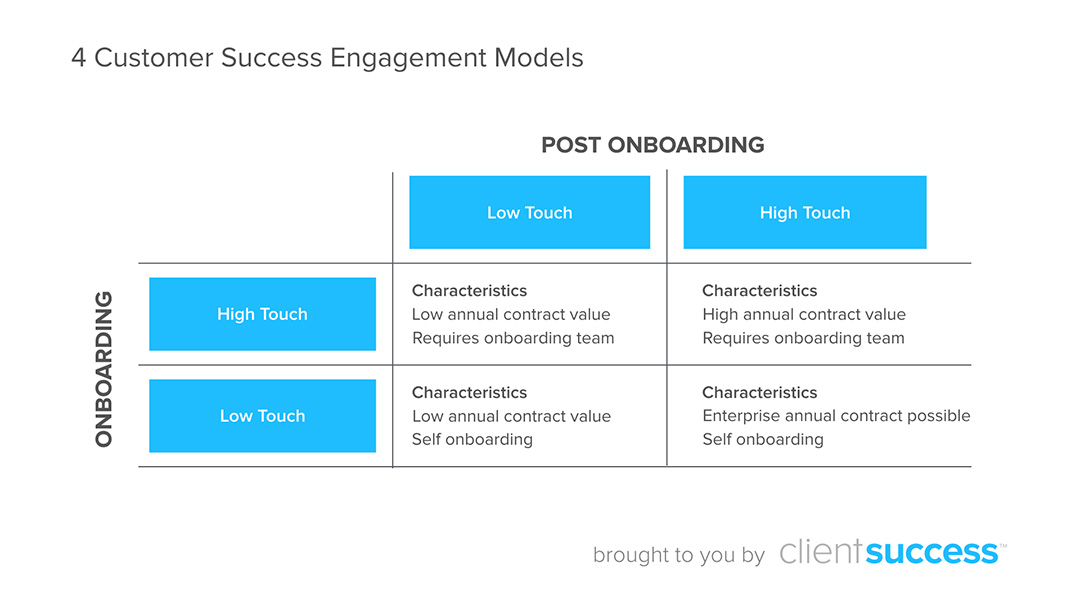Learn Four Customer Engagement Models and their Execution Strategies
Over the past decade, I've been involved in helping Software as a Service (SaaS) companies go from concept to hypergrowth. I have gone through that that journey three times with Workfront Formerly AtTask, Lendio, and now ClientSuccess. During each of these startup journeys we have had to develop a strategic way we engaged with our customers.
As we end 2016 and enter into 2017, the biggest impact in growth for a SaaS company will be in the ability to retain and grow their existing customer base. Revenue retention and growth of current customers is the catalyst to hypergrowth for SaaS companies.
There has also been the emergence of the customer success department to ensure the customer experience post sales lives up to product promises. Not only product promises—the leading customer success teams help deliver strong customer experiences with defined customer journey maps, engagement models, and experience analysis that drive brand fanatics. In this blog post I'll cover four customer engagement models and strategic approaches to the execution of these models.
Before we jump in to explore what types of engagement models are available to customer success organizations, let’s first define what we mean by engagement models.
What is an Customer Engagement Model?
In this post when I refer to the term “engagement model”, I’m referring to the process in which your organization approaches the management of the customer during their journey post sales.
Typically in the Software as a Service (SaaS) model there are two high level parts of the customer journey. The first part is onboarding a customer and the second part is driving adoption (value).
For some SaaS companies, onboarding of their software doesn’t require anyone (low touch) and for other SaaS companies it requires an individual to drive implementation (high touch). Then after onboarding you typically see two strategies: One is a high touch model to drive customer success with many touch points and check ins during the customer journey to renewal. Number two is a low touch model that uses strategies like product usage, engagement, and health scores to just respond to customers identified as at risk.
How Do You Get Started with the Right Engagement Model?
When you first start thinking about how you’ll engage with customers, it’s important to take a big step back and consider a few questions:
What’s your organization’s annual sales price? Will a model that has a high touch team with many CSMs and contributors actually support revenue growth, or will you need an engagement model that’s lower touch?
In this article, we’ll explore the 4 engagement models and the execution approaches so you and your team can determine which model best fits your organizational needs.
4 Engagement Models For Customer Success
In each of the below customer engagement models, we’ll explore what the onboarding and post onboarding process looks like for a variety of customer success teams, and then how those can be combined for a hybrid approach to ongoing customer success.
1. High Touch Onboarding
The first engagement model we’ll explore is the high touch onboarding model. After a deal is closed the customer typically is introduced to the implementation team to train and configure the solution through a very hands on approach.
Typically, this is a model used by enterprise software companies that are selling a somewhat complex solution where multiple individuals are involved in the buying process. This high touch onboarding model typically needs to drive enough revenue to cover the hands-on resources that are involved through the onboarding process. The more the deal is worth, the more resources can be assigned to the prospect account as the deal amount would cover the associated expenses.
2. Low Touch Onboarding
The second engagement model is a low touch onboarding approach. While this approach is still applicable to B2B software, it typically applies to software or tools that are seamless to use with little needed configuration that can be purchased directly through a website or even an app (think Dropbox or Slack).
A customer, rather than working with a dedicated resource, learns how to use the application via a training or onboarding tool – sometimes using a resource as simple as a video tutorial. An organization that selects this type of model would typically make product tips readily available, or ensure the product is so easy to use and intuitive that only in-app guidance is necessary. In select cases with this model, if an Enterprise organization is interested in purchasing the product or app, they will work with an assigned owner that will work through the deal accordingly.
3. High Touch Post Onboarding
With a high touch post onboarding approach, the customer may have been onboarded either online or with dedicated human resource, but the ongoing success of the account is managed with a high touch customer success manager (CSM) or a similar approach.
In this engagement model, the ongoing value of the customer is high enough and the product or service is complex enough that the cost of the CSM is covered by the revenue generated with the customer account.
In this model, a CSM may manage anywhere from a few large, complex enterprise customers to more mid-market type customers up to 40 or more, depending on the value of the customer account(s). In this scenario, CSMs may focus only on a certain segment, such as: enterprise, mid-market, or small business, with the number of assigned counts directly related to the strategic nature of each.
4. Low Touch Post Onboarding
With a low touch post onboarding approach, again the customer may have been onboarded either online or with a dedicated human resource, but in this engagement model the communication with the customer is almost completely conducted digitally or via an email-only approach.
In this scenario, CSMs are likely managing hundreds of accounts and use automation, alerts, and triggered messages to promote usage, train customers, or deliver best practices. They also use alerts and flags to determine who to talk to and when to talk. The annual deal size of the low touch engagement model is low.
Combining Engagement Models For Tailored Customer Success
When it comes to combining engagement models, many companies use a hybrid approach and combine the models that best work for their organization in their current state. Some organizations may even use one engagement model for enterprise companies and a different, lower touch model for mid-market or small businesses.
The key is to consider what the ideal engagement model looks like for your business and ensure that the revenue associated will cover the costs if a high touch model is used, or on the other end of the spectrum, ensure that corners aren’t cut by providing a low touch model with complex customers that may require a more personal relationship for ongoing success.
4 Hybrid Approaches to Customer Success Engagement
1. High Touch Onboarding / High Touch Post Onboarding
The first hybrid engagement model is the high touch onboarding approach paired with the high touch post onboarding approach. This is a typical model used for enterprise software companies or those selling into the enterprise space. ClientSuccess is an example of this type of engagement model. Those that visit the ClientSuccess website and request to learn more, for instance, will work with a dedicated individual throughout their sales cycle who will ensure the best solution is selected. And after the sale is complete, a CSM will work with the customer to ensure long term growth and success, using the high touch post onboarding model and working with the customer through implementation, renewal, and beyond.
2. High Touch Onboarding / Low Touch Post Onboarding
The second hybrid engagement model is the high touch onboarding approach paired with the low touch post onboarding approach. This model is used by companies that have a complex product or service that needs configuring or in-depth solutioning and may have multiple buyers involved in the process. However, after the sales is won, the customer transitions into more of a low touch approach or a maintenance approach where the account is managed digitally automation, alerts, and targeted communication.
3. Low Touch Onboarding / High Touch Post Onboarding
The third hybrid engagement model is the low touch onboarding approach paired with the high touch post onboarding approach. This model is typically used when a company can easily sign up for a product or service via a website, but requires more training and ongoing resources for success in the long term. For instance, Slack. Organizations of all shapes and sizes can sign up to use Slack with just a few simple clicks and a credit card, but for enterprise customers, they will work directly with a CSM to ensure they are using the full functionality and see the benefits long term. While the CSM may be managing many accounts, he or she does look after individual customers – not just a list of hundreds or thousands.
4. Low Touch Onboarding / Low Touch Post Onboarding
The final hybrid engagement model is the low touch onboarding approach paired with the low touch post onboarding approach. This model is typically used by very low cost applications or services companies where the product is very intuitive, and is usually automatically charged either on a monthly or annual basis.
For organizations using this approach, it wouldn’t be feasible to have dedicated CSMs looking after each account as the revenue generated wouldn’t be able to cover the cost of the human resource. In fact, a CSM (if one exists) in this scenario usually looks after hundreds or thousands of customers and is only monitoring red flags. An example of a company that uses this approach is again Dropbox. If you have used Dropbox, you know how low touch and seamless the signup process is, and you have also received the emails from Dropbox prompting you to update your credit card, or use more of the benefits the tool provides – but likely nothing beyond that.
As you segment your customers, you can use the above engagement models to determine what is the best approach to deliver real value and retained customers. Now it's time to get to work and define your customer engagement models and how you will execute those models in a way that drives value. Remember this important fact—recurring revenue requires an customer experience that delivers recurring value.


